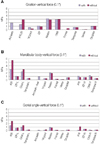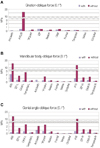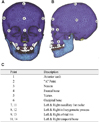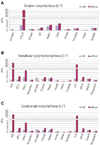This article has been corrected. See "Erratum: Finite element analysis of the effects of a mouthguard on stress distribution of facial bone and skull under mandibular impacts" in Volume 50 on page 217.
Abstract
Purpose
The purpose of this study was to investigate the effects of a mouthguard on stress distribution under mandibular impact.
Materials and methods
The FEM model of head consisted of skull, maxilla, mandible, articular disc, teeth, and mouthguard. The impact locations on mandible were gnathion, the center of inferior border, and the anterior edge of gonial angle. And the impact directions were vertical, oblique (45°), and horizontal. The impact load was 800 N for 0.1 sec.
Results
When vertical impact was applied, the similar stress and the distribution pattern was occurred without the relation of the mouthguard use (P>.05). The model with mouthguard was dispersed the stress to the teeth, the facial bone and the skull when the oblique (45°) impacts were happened. However, the stress was centralized on the teeth in the model without mouthguard (P<.05). The model with mouthguard was dispersed the stress to the teeth, the facial bone and the skull when the horizontal impacts was occurred. However, the stress was centralized on the teeth without mouthguard (P<.05). For all impact loads, stress concentrated on maxillary anterior teeth in model without mouthguard, on the contrary, the stress was low in the model with mouthguard and distributed broadly on maxillary anterior teeth, facial bone, and skull.
Figures and Tables
 | Fig. 5Stress distribution on reference point of maxilla and skull according to with mouthguard (left bar) and without mouthguard (right bar) state for vertical force on A: gnathion, B: mandibular body, C: gonial angle. |
 | Fig. 6Stress distribution on reference point of maxilla and skull according to with mouthguard (left bar) and without mouthguard (right bar) state for oblique force on A: gnathion, B: mandibular body, C: gonial angle. |
References
2. Ranalli DN. Prevention of craniofacial injuries in football. Dent Clin North Am. 1991. 35:627–645.
3. Barth JT, Freeman JR, Winters JE. Management of sports-related concussions. Dent Clin North Am. 2000. 44:67–83.

4. Ferrari CH, Ferreria de Mederios JM. Dental trauma and level of information: mouthguard use in different contact sports. Dent Traumatol. 2002. 18:144–147.

5. Sane J, Ylipaavalniemi P. Dental trauma in contact team sports. Endod Dent Traumatol. 1988. 4:164–169.

6. Clegg JH. Mouth protection for the rugby football player. Br Dent J. 1969. 127:341–343.
7. Heintz WD. Mouth protectors: a progress report. Bureau of Dental Health Education. J Am Dent Assoc. 1968. 77:632–636.
8. Keçeci AD, Eroglu E, Baydar ML. Dental trauma incidence and mouthguard use in elite athletes in Turkey. Dent Traumatol. 2005. 21:76–79.

9. Lee DK, Yim CJ. The clinical study of mandibular fracture. J Korean Acad Maxillofac Plast Surg. 1989. 11:69–78.
10. Jang HS, Jang MJ. A Clinical study on the facial bone fracture. J Korean Assoc Maxillofac Plast Reconstr Surg. 1996. 18:454–456.
11. Sohn MB, Park IH, Park BY. Fractures of the Mandible: A Review of 250 cases. J Korean Soc Traumatol. 1994. 7:51–53.
12. Jang HS, You JY, Kim YK, Yang BE. A clinical study on mandiblar fracture. J Korean Assoc Maxillofac Plast Reconstr Surg. 1997. 19:181–182.
13. Jang KY, Shin MJ, Kim DG. A clinical study on facial bone fracture. J Korean Assoc Maxillofac Plast Reconstr Surg. 1995. 17:379–388.
14. Sane J. Comparison of maxillofacial and dental injuries in four contact team sports: American football, bandy, basketball, and handball. Am J Sports Med. 1988. 16:647–651.

15. McCarthy MF. Sports and mouth protection. Gen Dent. 1990. 38:343–346.
16. Godwin WC. The role of the sports team dentist. Dent Clin North Am. 1991. 35:701–705.
17. Jang JM, Lee SB. A qualitative and quantitative study on occlusal conditions in health volunteers and athletes with normal occlusion. J Korean Acad Prosthodont. 1998. 36:302–322.
18. Levin L, Friedlander LD, Geiger SB. Dental and oral trauma and mouthguard use during sport activities in Israel. Dent Traumatol. 2003. 19:237–242.

19. Bayraktar HH, Morgan EF, Niebur GL, Morris GE, Wong EK, Keaveny TM. Comparison of the elastic and yield properties of human femoral trabecular and cortical bone tissue. J Biomech. 2004. 37:27–35.

20. Kumaresan S, Radhakrishnan S. Importance of partitioning membranes of the brain and the influence of the neck in head injury modelling. Med Biol Eng Comput. 1996. 34:27–32.

21. Iwata T, Watase J, Kuroda T, Tsutsumi S, Maruyama T. Studies of mechanical effects of occlusal force on mandible and temporomandibular joint. J Osaka Univ Dent Sch. 1981. 21:207–215.
22. Tanaka E, Tanne K, Sakuda M. A three-dimensional finite element model of the mandible including the TMJ and its application to stress analysis in the TMJ during clenching. Med Eng Phys. 1994. 16:316–322.

23. Miyazaki M, Inage H, Onose H. Use of an ultrasonic device for the determination of elastic modulus of dentin. J Oral Sci. 2002. 44:19–26.

24. Cho SJ, Kim YG. The study on mandibular fracture mechanism using dynamic 3-dimensional finite analysis. J Korean Assoc Maxillofac Plast Reconstr Surg. 2002. 24:470–481.
25. Westerman B, Stringfellow PM, Eccleston JA. Forces transmitted through EVA mouthguard materials of different types and thickness. Aust Dent J. 1995. 40:389–391.

26. Flanders RA, Bhat M. The incidence of orofacial injuries in sports: a pilot study in Illinois. J Am Dent Assoc. 1995. 126:491–496.

27. Newsome PR, Tran DC, Cooke MS. The role of the mouthguard in the prevention of sports-related dental injuries: a review. Int J Paediatr Dent. 2001. 11:396–404.

28. Stenger JM, Lawson EA, Wright JM, Ricketts J. Mouthguards: protection against shock to head, neck and teeth. J Am Dent Assoc. 1964. 69:273–281.




 PDF
PDF ePub
ePub Citation
Citation Print
Print











 XML Download
XML Download